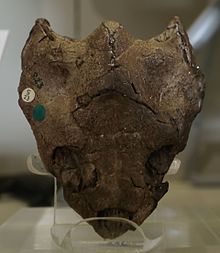Dorsetochelys is an extinct genus of turtle from the Early Cretaceous of southern England and northwestern Germany.
| Dorsetochelys Temporal range: Late Jurassic-Early Cretaceous
| |
|---|---|

| |
| Scientific classification | |
| Domain: | Eukaryota |
| Kingdom: | Animalia |
| Phylum: | Chordata |
| Class: | Reptilia |
| Clade: | Pantestudines |
| Clade: | Testudinata |
| Clade: | †Paracryptodira |
| Family: | †Pleurosternidae |
| Genus: | †Dorsetochelys Evans and Kemp, 1976 |
| Species | |
|
D. delairi Evans and Kemp, 1976 (type) | |
| Synonyms | |
|
Pleurosternon typocardium Seeley, 1869 | |
Taxonomy
editThe type species, Dorsetochelys delairi, was described on the basis of DORCM G.23, a complete skull from the Early Cretaceous (Berriasian) Purbeck Group of Dorset, England.[1] Later, a turtle skull from the vicinity of Como Bluff, Wyoming, was described as a new species, D. buzzops, in honor of Buzz Pitman, a museum director of the Rock River Museum near Como Bluff.[2] However, a cladistic analysis conducted in 2013 recovered that species as a member of Baenidae, sister to Uluops.[3]
In 2012, pleurosternid remains were described from the Early Cretaceous (Berriasian) Bückeberg Formation of Lower Saxony, northwestern Germany, and this prompted a re-assessment of the problematic species "Pleurosternon" typocardium, which had been tentatively referred to Glyptops by Milner (2004).[4] The new genus Ballerstedtia was coined for "P." typocardium, and the remains from Lower Saxony were named B. bueckergensis.[5] In a paper published in 2014, Ballerstedtia was synonymized with Dorsetochelys.[6]
References
edit- ^ Evans and Kemp, 1976. A new turtle skull from the Purbeckian of England and a note on the early dichotomies of cryptodire turtles. Palaeontology, 19, 317–324.
- ^ R. T. Bakker. 1998. Dinosaur mid-life crisis: the Jurassic-Cretaceous transition in Wyoming and Colorado. Lower and Middle Cretaceous Terrestrial Ecosystems, New Mexico Museum of Natural History and Science Bulletin 14:67-77
- ^ D. W. Larson, N. R. Longrich, D. C. Evans and M. J. Ryan. 2013. A new species of Neurankylus from the Milk River Formation (Cretaceous: Santonian) of Alberta, Canada, and a revision of the type species N. eximius. Morphology and Evolution of Turtles 389-405.
- ^ A. R. Milner. 2004. The turtles of the Purbeck Limestone Group of Dorset, southern England. Palaeontology 47(6):1441-1467
- ^ H.-V. Karl, E. Groning, C. Brauckmann, and M. Reich. 2012. Ballerstedtia bueckebergensis, a new turtle from the Early Cretaceous Wealden facies of Germany (Testudines: Pleurosternidae). Studia Palaeocheloniologica 4:47-60.
- ^ A. Perez-Garcia. 2014. Revision of the poorly known Dorsetochelys typocardium, a relatively abundant pleurosternid turtle (Paracryptodira) in the Early Cretaceous of Europe. Cretaceous Research 49:152-162.